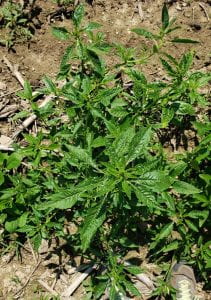This past week, members of the Edgewood Farm team, along with myself, tackled the exciting job of hand pulling waterhemp from a field of snap beans. Waterhemp is in the Amaranth family which also includes other commonly found pigweed species. Because it is a relative of pigweed, it can often be difficult to distinguish between the different species, especially as seedlings. As waterhemp matures it becomes a little easier to identify because mature plants tend to have glossy and elongated leaves. You might be wondering why we had to pull it by hand. Unfortunately, waterhemp is resistant to many of the herbicides on the market today and that surly seems to be the case here since it was unphased by last years and this year’s herbicide applications. Left unchecked the waterhemp would quickly spread out of control because a single plant can produce upwards of one million seeds.
On a more exciting note, wheat harvest is finally under way in Western New York. As a bit of an experiment, a field of wheat was intercropped with soybeans for the first time at Edgewood. Instead of planting the wheat with a grain drill, as is conventionally done, they planted it with their twin-row planter. Then in May, the same twin-row planter was used to plant soybeans in between the rows of wheat. Last Thursday, the combine headed to the field to harvest the wheat and it yielded surprisingly well considering how poor it looked earlier thus year (lots of winter kill and drowned wheat). Even though I will be back in school when soybean harvest takes place it will be exciting to hear how they turn out. I imagine I will see more cropping systems like this in the future from Edgewood if this goes well and on paper it looks like it will return the largest profit per acre of all their crops.



